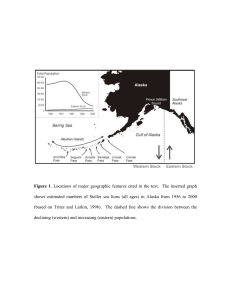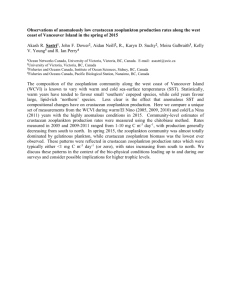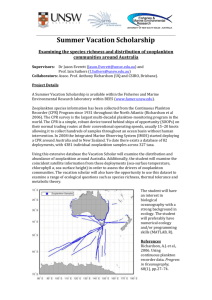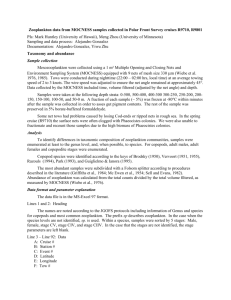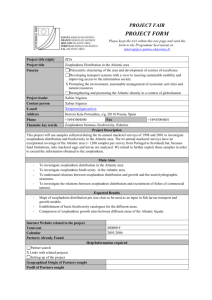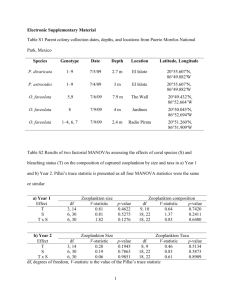Long-Term Variability in the North Pacific as Indicated by a Coupled
advertisement
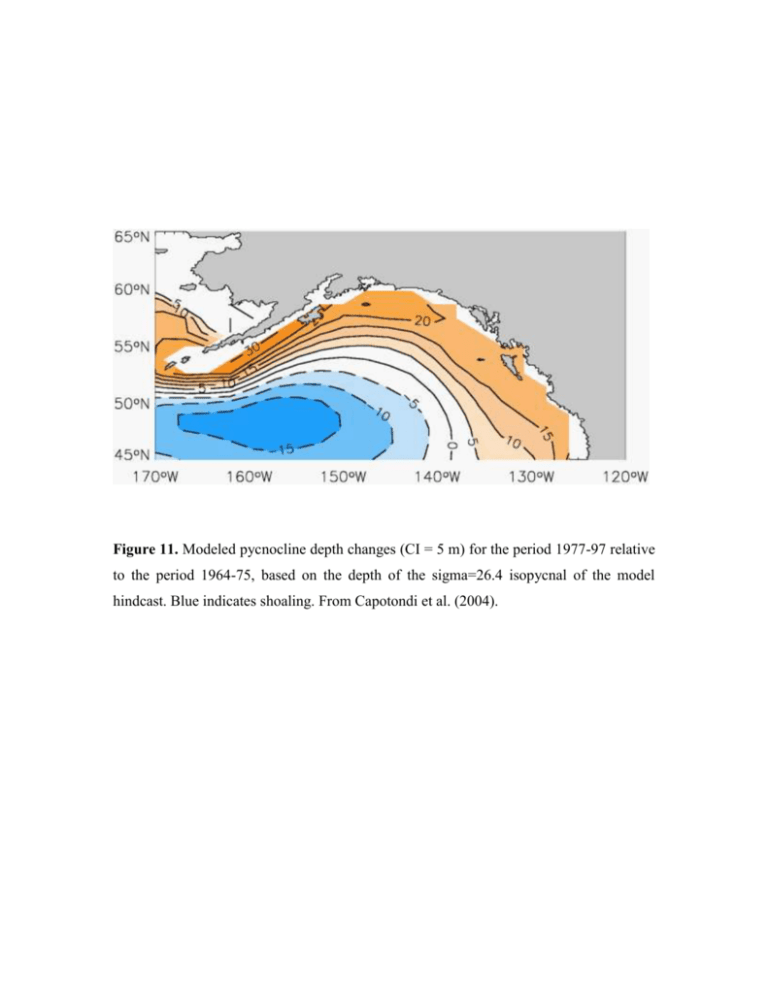
Figure 11. Modeled pycnocline depth changes (CI = 5 m) for the period 1977-97 relative to the period 1964-75, based on the depth of the sigma=26.4 isopycnal of the model hindcast. Blue indicates shoaling. From Capotondi et al. (2004). Figure 12. Modeled variance (CI = 100 cm2/s2) of the anomalous monthly mean surface currents for the 10-year epochs 1967-1976 (top) and 1979-1988 (middle), and the difference between the two epochs (bottom). Anomalies are defined with respect to the monthly mean seasonal cycle of the respective 10-year epoch. From Miller et al. (2004). 2 Figure 13. (a) Large zooplankton (mmol m-3) during 1977-1998 minus 1960-1976 in a physical-ecosystem ocean model’s top layer during May when the large zooplankton amount peaks. (b) The biomass of the four plankton classes (mmol m-3) in each calendar month during 1960-1976 (solid lines) and 1977-98 (dashed lines) in the Gulf of Alaska region [46ºN-58ºN, 160ºW-140ºW, indicated by the box in (a)]. 3 Figure 14. March mixed layer depth (m) in 1977-1998 minus 1960-76 from an ocean model hindcast. 4 Figure 15. Depth-averaged (0-100 m) model velocity (cm/s) snapshots near the Amukta Pass from the end of (a) March and (b) May of 1984 showing effect of a mesoscale eddy modeled within the Alaskan Stream on the flow across the Amukta Pass. The green solid contours represent bathymetry (m). (c) The salinity difference (ppt) along the section marked “Cross Slope” between eddy (May) and no-eddy (March) conditions. From Maslowski and Okkonen (2004). 5 Figure 16. Nonlinear principal component analysis results from a multivariate dataset of 45 biotic indices (fishery and survey records) from the Bering Sea and Gulf of Alaska from 1965-2001. Error bars computed as in Figure 5. From Marzban et al. (2004). 6 Figure 17. Non-parametric Kendall’s tau statistic to assess the statistical significance of trends in (a) Steller sea lion data, (b) Pacific fishery data and (c) Pacific climate data. and While a “trend" often means a linear trend, Kendall's tau assesses the trend nonlinearly (though monotonically). The Z-statistic assesses the statistical significance of that trend such that if Z ≥ 2.575 then the hypothesis that the true tau is zero can be rejected with 99% confidence. From Marzban et al. (2004). 7 Figure 18. Underway sea surface salinity (psu) during 2001 cruise. (a) Salinity plotted against latitude. (b) Salinity represented by colored line on map. Average salinity in the regions east of Unimak Pass, between Unimak and Samalga Passes, and between Samalga Pass and Amukta Pass are noted. From Ladd et al. (2004). 8 Unweighted Means by Transect and Species 0.6 Mean Abundance (No. m-3) 0.5 Thysanoessa inermis Euphausia pacifica 0.4 0.3 0.2 0.1 0.0 Un1 Ak1 Tng Sgm Smg Un2 Ak2 Transect Unweighted Means vs Transect and Species 600 Mean Abundance (No. m-3) 500 Calanus marshallae N. plumchrus & N. flemingeri Acartia spp. 400 300 200 100 0 Ak1 Un1 Tng Sgm Amk Smg Unk Ak2 Un2 Transect Figure 19. Mean abundance of zooplankton species versus station seasonal influences and water mass influences on zooplankton species composition. Pass Names: Um1 = Unimak (May), Ak1 = Akutan (May), Tng = Tananga (June), Sgm = Seguam (June), Smg = Samalga (June), Un2 = Unimak (June), Ak2 = Akutan (June). The error bars are 95% confidence intervals for power transformed mean abundance in the respective passes. The broad error bars are due to the very patchy distribution of these organisms, especially in the passes where tidally generated eddies can physically concentrate or disperse zooplankton. From Coyle (2004). 9 54 Short-tailed shearwaters 52 -178 -176 -174 -172 -170 -168 -166 -164 -170 -168 -166 -164 Northern fulmars 54 52 -178 -176 -174 -172 Tufted puffins 54 52 -178 -176 -174 -172 -170 -168 -166 -164 -172 -170 -168 -166 -164 Small alcids 54 52 -178 -176 -174 Figure 20. Seabird abundances along the Aleutian Islands. From Jahncke et al. (2004). 10 Figure 21. Paleoproductivity indicators over the last 300 years derived from two cores in the Gulf of Alaska (GAK 4 site central gulf shelf) and Bering Sea (Skan Bay). Map in lower right shows locations. Two productivity indicators are plotted for each core: opal, which represents diatom productivity (blue) and delta 13C of organic matter (red) which represents all organic productivity. Increases in productivity would be indicated by an increase in either indicator. From Finney (2004). 11 Climate 400 warmer? 800 no SSL 1200 cool, wet 1600 2000 2400 cool, mesic 2800 Years Before Present cool, wet 3200 warm, mesic 3600 4000 50 40 30 20 10 0 Below Average Percent SSL 10 20 30 40 Above Average Percent SSL Figure 22. Long term trends in the percentage of Steller Sea lions harvested by Alaska Peninsula Aleut in relation to their total sea mammal harvest. The Aleut harvested resources in proportion to their actual distribution on the landscape. This chart shows the percentage difference from the mean harvest over the last 4000 years. Climate data based pollen cores and other data of the Alaska Peninsula Project (Jordan and Maschner 2000; Jordan and Krumhardt, 2003) and data provided by Finney. 12 50 Figure 23. Conceptual model showing how regime shifts might have affected sea lion numbers through bottom-up processes that influenced suites of species and had positive and negative effects on sea lion health and numbers (see Fig. 2 for further details). 13
